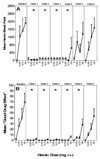The role of human drug self-administration procedures in the development of medications
- PMID: 18436394
- PMCID: PMC2744317
- DOI: 10.1016/j.drugalcdep.2008.03.001
The role of human drug self-administration procedures in the development of medications
Abstract
The purpose of this review is to illustrate the utility and value of employing human self-administration procedures in medication development, including abuse liability assessments of novel medications and evaluation of potential pharmacotherapies for substance use disorders. Traditionally, human abuse liability testing has relied primarily on subjective reports describing drug action by use of questionnaires; similarly, drug interactions between putative treatment agents and the drugs of abuse have relied on these measures. Subjective reports are highly valued because they provide qualitative and quantitative information about the characteristics of central and peripheral pharmacodynamic effects as well as safety and tolerability. However, self-administration procedures directly examine the behavior of interest-that is, drug taking. The present paper (1) reviews the most commonly used human self-administration procedures, (2) discusses the concordance of subjective reports and self-administration within the context of medications development for substance use disorders, focusing primarily on illustrative examples from development efforts with opioid and cocaine dependence, and (3) explores the utility of applying self-administration procedures to assess the abuse liability of novel compounds, including "abuse-deterrent" formulations (ADFs). The review will focus on opioid and cocaine dependence because a rich database from both clinical laboratory and clinical trial research exists for these two drug classes. The data reviewed suggest that drug-induced changes in self-administration and subjective effects are not always concordant. Therefore, assessment of self-administration in combination with subjective effects provides a more comprehensive picture that may have improved predictive validity for translating to the clinical setting.
Figures


References
-
- Abreu ME, Bigelow GE, Fleisher L, Walsh SL. Effect of intravenous injection speed on responses to cocaine and hydromorphone in humans. Psychopharmacol. 2001;154:76–84. - PubMed
-
- Altman JL, Meyer RE, Mirin SM, McNamee, McDougle HB. Opiate antagonists and the modification of heroin self-administration behavior in man: An experimental study. Int. J. Addict. 1976;11:485–499. - PubMed
-
- Amass L, Bickel WK, Crean JP, Blake J, Higgins ST. Alternate-day buprenorphine dosing is preferred to daily dosing by opioid-dependent humans. Psychopharmacol. 1998;136:217–225. - PubMed
-
- Amass L, Kamien JB, Rieber C, Branstetter SA. Abuse liability of i.v. buprenorphine-naloxone, buprenorphine, and hydromorphone in buprenorphine-naloxone maintained volunteers. Drug Alcohol Depend. 2000;60 Suppl 1:S6–S7.
-
- Arnold JM, Roberts DCS. A critique of fixed and progressive ratio schedules used to examine the neural substrates of drug reinforcement. Pharmacol. Biochem. Behav. 1997;57(3):441–447. - PubMed

